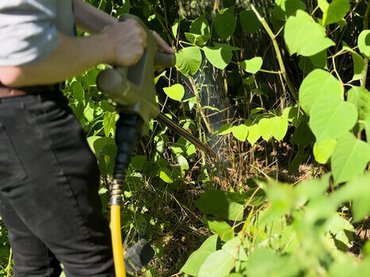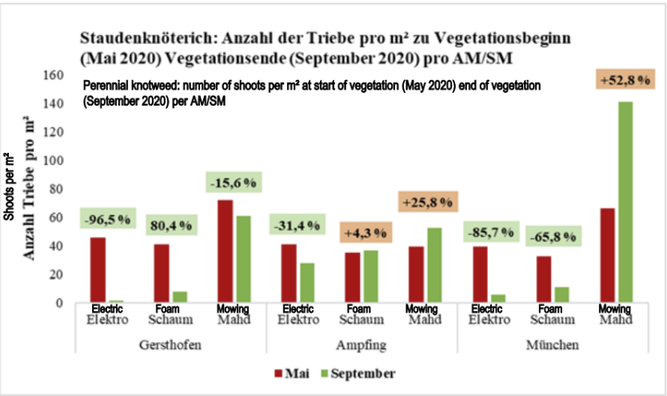Using Electricity to kill Japanese Knotweed
Invasive plants such as Japanese Knotweed have previously been difficult to treat without chemicals. Now we have proven solutions using electricity, which can be just as effective as herbicides.
Japanese knotweed - an invasive plant that reqiures treatment

• Germination: Unknown
• Growth height: up to 4 meters (growth up to 30 cm per day)
• Flowering: August
• Spread: Mass spread through rhizome fragments that have predetermined breaking points and thus break off even more easily and are transported onwards with water or soil
• Competitive power: Extremely high. Forms dominant stands through rhizomes within a very short time, displacing all other (native) plants
• Particularly problematic in areas of embankments. The soil is excessively loosened by these plants. loosened by these plants. The result is that the bank reinforcement is washed away or broken off: flood protection is no longer guaranteed.
Treating Japanese Knotweed with Electricity
Our new Electric Weedkiller from Kersten is the ideal tool for dealing with populations of Japanes Knotweed and other invasive species.
This is because, the electricity can provide a systemic kill through the deep root systems. Repeated treatment can successfully manage large populations of plants over a few years.

The Principle -
The system is based on electrophysical technology. The device generates a very high current pulse at the touch of a button, thereby eliminating unwanted plants in a targeted manner. The power module supplies the high voltage required for this, this current flows via the hand lance into the plant and then into the substrate. The circuit is closed again via the current feedback earth spike, which is inserted into the soil via another cable. The energy boils the water inside the plant and thus destroys the plant structure.
The result:
• The plant‘s chlorophyll is immediately damaged, the cells are irreversibly destroyed and die
• The water supply to the cells is interrupted
• The plant dries out
The right amount of energy and optimized ground contact are decisive for the effect: Plants with a high water content and, compared to their leaf mass, with few stems and roots require little energy and are easy to treat. Very dense and woody wild herbs or very large plants require a lot of energy. In these cases, methods combined with mowing, for example, achieve the best results, as the young new shoots carry a particularly large amount of water and therefore direct the flow even better into the plant. Plants with larger rootstocks or rhizomes are severely weakened and sometimes have to be treated several times before they are completely destroyed.
You can see a video testimonial from a contractor for Transport for London here
Below are the results of a trial in three different areas of germany, using different treatments for Japanese Knotweed.
The trial was conducted by BOKU University of Natural Resources and Life Sciences in Vienna.
Electrocution of Japanese Knotweed had the greatest effect at reducing the number of shoots per meter squared out of any of the methods used, dramatically reducing the populations within just a few months.

For more information on the Kersten Electric Weedkiller click here!
No comments yet. Login to start a new discussion Start a new discussion